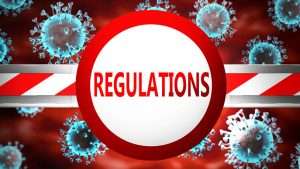The Cal/OSHA Standards Board voted 6-1 yesterday to continue California’s COVID-19 regulation until December 2024.
As part of the transition from an emergency COVID-19 regulation into a nonemergency one, Cal/OSHA has made some changes that will improve feasibility for California’s workplaces.
What Stays the Same for Workplaces?
The basic framework of the nonemergency COVID-19 regulation is going to be familiar to human resources professionals and lawyers who have grappled with applying the regulation across the state for the last two years.
It will continue to apply to the same work locations and rely on the same basic tools: identifying COVID-19 cases in the workplace, excluding any employee cases, identifying and providing no-cost testing of close contacts, and following outbreak protocols if three or more cases occur.
‘New’ Close Contacts Definition: Spreading a Wider Net
The most profound administrative change was arguably made earlier this year, when the California Department of Public Health (CDPH) changed the definition of a “close contact” to hinge on the size of the workplace, but this change is being incorporated into the text of the two-year regulation, so it deserves a re-examination.
For “indoor spaces larger than 400,000 cubic feet per floor, a close contact is … being within six feet for a cumulative total of 15 minutes or more over a 24-hour period.” Alternatively, for “indoor airspaces of 400,000 cubic feet or fewer per floor, a close contact is … sharing the same indoor airspace as a COVID-19 case for 15 minutes or more over a 24-hour period.”
This change has created ongoing operational questions for employers across California as they struggle with implementation questions. For example: if I have doors that open and close regularly — such as between a loading area and open floor — is that one unified “indoor airspace”? Or must the doors be open constantly? And if doors or windows are consistently left open, allowing airflow in and out of an area, how is that area treated? And, for spaces smaller than 400,000 cubic feet, is a person 100 feet away from another for 15 minutes really a “close” contact?
So although the word “close contact” remains the yardstick of the regulation, employers should keep in mind that this word will no longer mean the well-known 6-foot/15-minutes standard of prior years.
Other Significant Changes: Outbreaks, Exclusion Pay, and More
Among other significant changes, employers should know that outbreak protocols can end slightly sooner under the new text. Whereas outbreak protocols previously had to continue until an employer had a two-week period with zero cases in the exposed group (regardless of whether that was caused by a workplace exposure), the new text will allow outbreaks to end so long as one or less cases occur in a two-week period.
This change was one that the California Chamber of Commerce had proposed, and means that the outbreak trigger (three cases or more in an exposed group) is now more in line with the outbreak exit threshold (one or fewer cases).
In addition, exclusion pay is being removed from the regulation, meaning employers will no longer be required to provide unlimited paid sick leave whenever a COVID-19 case occurs in the workplace. Notably, the employer still will be required to keep cases out of the workplace pursuant to the regulation, and excluded employees will be eligible for existing sick leave protections and workers’ compensation, as well as being protected from discipline related to their COVID-19 status under existing labor law protections.
When Do the Changes Go Into Effect?
The new two-year version does not necessarily go into effect on January 1; instead, it goes into effect when the Office of Administrative Law has reviewed and approved the text. This is important for California employers to understand because it means that the present text may technically remain in effect until as late as mid-January.
What Else to Expect in 2023 for California’s COVID Regulation?
With yesterday’s vote, the California business community should see a slowing of the rate of change for the COVID-19 regulation. Over the last few years, the COVID-19 regulation’s text (as well as the related FAQs and CDPH guidance) have been a fast-moving target, with tweaks and updates every few months. The frequent changes have pushed human resources professionals, attorneys, and particularly small business owners into a frenzied state of constant catch-up.
With this new two-year regulation approved as a nonemergency regulation, the CalChamber expects that the Cal/OSHA staff (who wrote and rewrote the regulation and FAQs) will be trying to refocus their efforts on other priorities and will leave this text largely alone.
Those other agency priorities include: bringing an update to California’s lead regulation and a new workplace violence regulation before the Standards Board for notice and formal rulemaking; and holding advisory committee discussions on other rulemakings, including updates to the state’s first aid regulation and walking-working surfaces regulation.
Staff Contact: Robert Moutrie


